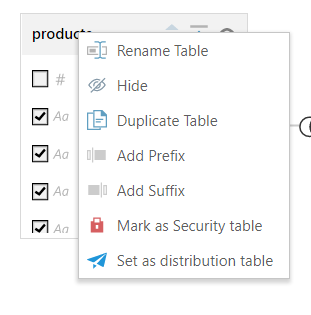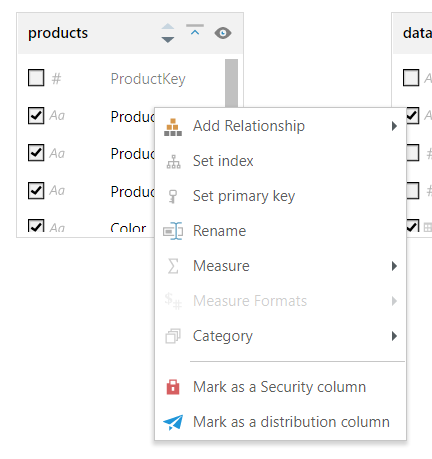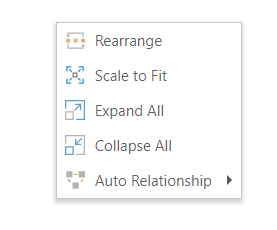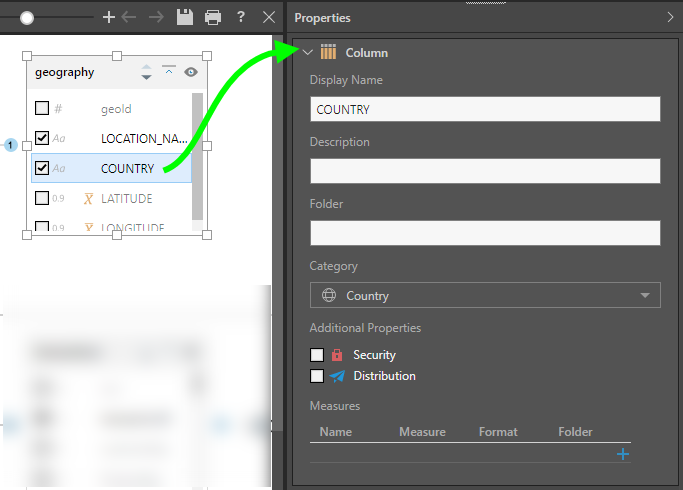Most functions available in the Tables panel can be accessed via the right click context menus, or the Properties panels.
Context Menus
Context menus are accessed by right clicking on the table, column, or background. The context menu will display a list of functions according to the item that was clicked on.
Table Context Menu
Right click at the top of a table to open its context menu:
- Rename Table: change the name of the table in the data model, without changing it in the source database (which is done in the Data Flow).
- Hide: hide the table and all its columns. To show hidden tables in the diagram, select 'Show All Tables' from the ribbon. To un-hide a hidden table, select 'Show All Tables' from the ribbon and then right click on the hidden table and select Show from the context menu.
- Duplicate Table: duplicate a table in the data model.
- Add Prefix: add a prefix to the table name and/ or column names.
- Add Suffix: add a suffix to the table name and/ or column names.
- Mark as a Security Table: mark the table as a security table to hide it in the data model.
- Set as Distribution Table: mark as a distribution table; the table will not appear in the data model, but will be available for dynamic distribution of publications.

Column Context Menu
Right-click a column to:
- Add Relationship: add a relationship from the given to column to a column chosen from the context menu.
- Set Index: add an index to the given column.
- Set primary key: set the given column as the table's primary key; this should be the primary key in the data source.
- Rename: rename the column in the data model.
- Measure: apply a measure aggregation type to the given column in the data model.
- Measure Formats: apply a measure format to the specified measure column in the data model.
- Category: categorize the column by selecting a logical type from the Category list.
- Mark as a Masked Column: mark the column to indicate that its values should be masked when viewed by users with a particular role. Note: Selecting this option only enables dynamic masking, you will also need to associate the flagged column with a role in your model settings to complete the process.
- Mark as a Security Column: mark the column as a security column to hide it in the data model.
- Mark as a Distribution Column: mark as a distribution column; the column will not appear in the data model, but will be available for dynamic distribution of publications.

Background Context Menu
Right click on the background to:
- Rearrange: click to rearrange the tables into their original positions (after moving them).
- Scale to Fit: scale the diagram down to fit the canvas.
- Expand All: expand all tables so that their columns can be viewed.
- Collapse All: collapse all tables so their columns are not visible.
- Auto Relationship: choose the algorithm that should be used to define the relationships (joins) in the model.

Properties Panels
The Properties panel can be opened by left clicking on a table or column. The properties for the selected table or column will be displayed and can be edited.
Table Properties
Click on a table to open its Properties panel, where you can edit the:
- Display Name: the same as the 'Rename Table' function listed above.
- Description: add a description to the table. Unlike column descriptions, table descriptions do not appear in the tooltips.
- Additional Properties:
- Security: the same as the 'Mark as a Security Table' function listed above.
- Distribution: the same as the 'Mark as Distribution Table' function listed above.

Column Properties
Click a column in the widget to open its Properties panel, where you can change the column's:
- Display Name: same as the 'Rename' function listed above.
- Description: add a description to the column.
- Folder: create a folder where the column should be located.
- Category: same as the 'Category' function listed above.
- Security: same as the 'Mark as a Security Column' function listed above.
- Distribution: the same as the 'Mark as a Distribution Column' function listed above.
- Measures: set the column's measure aggregation and format, measure name, description, and folder.
